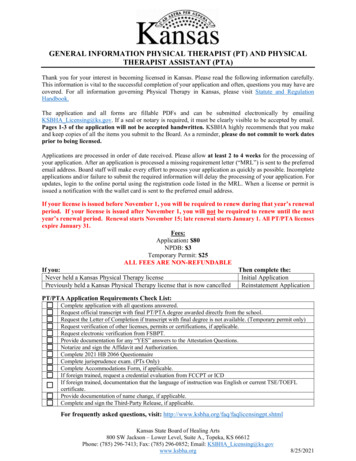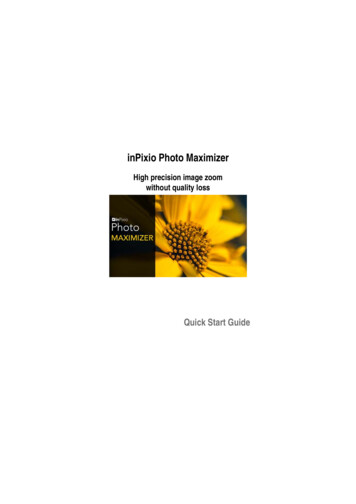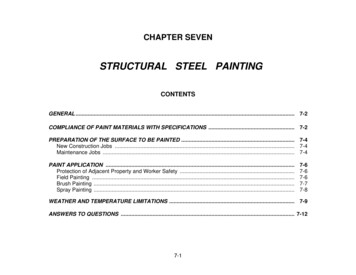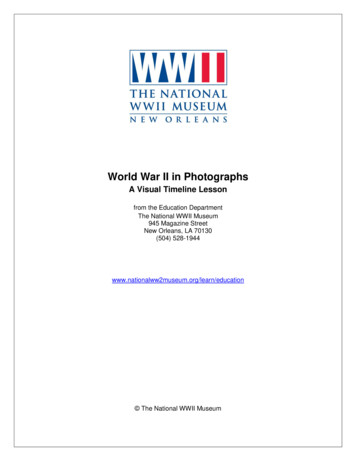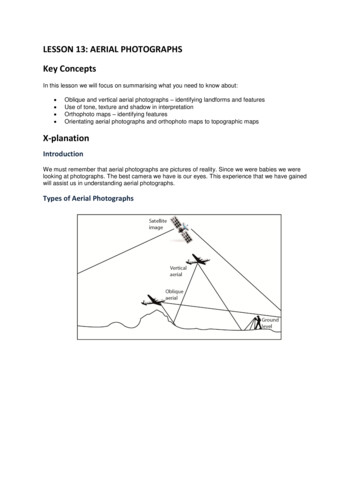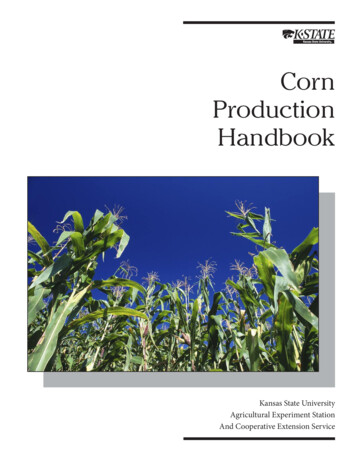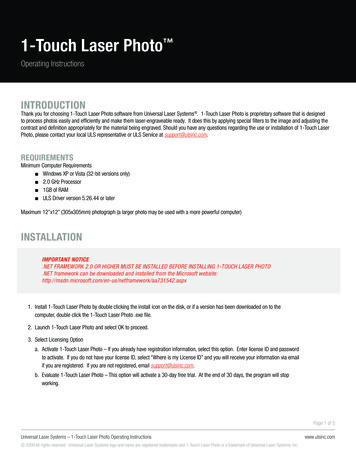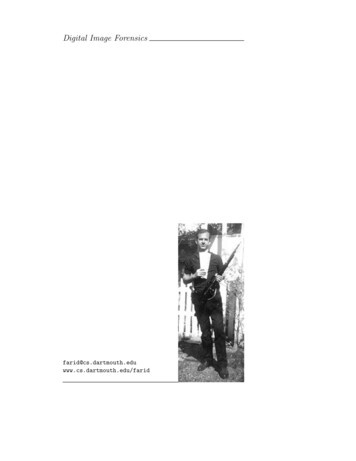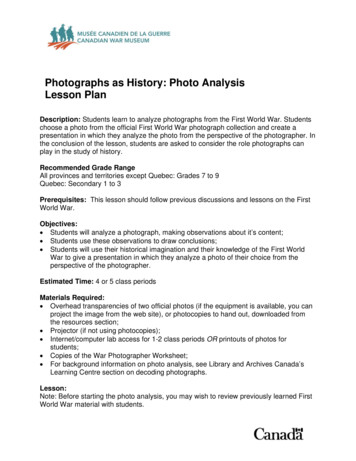
Transcription
Photographs as History: Photo AnalysisLesson PlanDescription: Students learn to analyze photographs from the First World War. Studentschoose a photo from the official First World War photograph collection and create apresentation in which they analyze the photo from the perspective of the photographer. Inthe conclusion of the lesson, students are asked to consider the role photographs canplay in the study of history.Recommended Grade RangeAll provinces and territories except Quebec: Grades 7 to 9Quebec: Secondary 1 to 3Prerequisites: This lesson should follow previous discussions and lessons on the FirstWorld War.Objectives: Students will analyze a photograph, making observations about it’s content; Students use these observations to draw conclusions; Students will use their historical imagination and their knowledge of the First WorldWar to give a presentation in which they analyze a photo of their choice from theperspective of the photographer.Estimated Time: 4 or 5 class periodsMaterials Required: Overhead transparencies of two official photos (if the equipment is available, you canproject the image from the web site), or photocopies to hand out, downloaded fromthe resources section; Projector (if not using photocopies); Internet/computer lab access for 1-2 class periods OR printouts of photos forstudents; Copies of the War Photographer Worksheet; For background information on photo analysis, see Library and Archives Canada’sLearning Centre section on decoding photographs.Lesson:Note: Before starting the photo analysis, you may wish to review previously learned FirstWorld War material with students.
Photographs as History: Photo AnalysisLesson PlanExplain to students that they will be looking at photos from the First World War andanalyzing them. This is one way historians research the past, as photos can provideinformation that enriches our historical understanding.Show the class one of the photos you have selected, and tell students that it was takenby an official Canadian war photographer. Model an analysis of the photograph for theclass by clearly describing the people, objects, and setting of the photograph, and theninferring from this the mood of the photo, what additional information the captionprovides, and why the photo might have been taken.Now, show students a second photo. This time, guide students through an analysis of thephotograph based on what has just been modeled. Use questions to prompt students tocontribute their observations. Prompts may include: What is the caption?Are there people in the photograph?What do they look like?Who might they be?What are they doing?Where are they? What is in the background?Is the photo posed or spontaneous?Why might the photographer have taken the photo?What message do you think the photographer was trying to get across with thisphotograph?What if a new caption is written? Does the caption change how the photo is viewed?Book one class period in the computer lab (you may need two), and ask students toselect a First World War photo that interests them from the Official Photographs sectionof the Canadian War Museum’s Canada and the First World War Web site. Alternatively,distribute printouts of a different photo from the archive to each student. Students will usetheir photo to do their own photo analysis.Once students have selected or been assigned their photographs, distribute the WarPhotographer Worksheet. Ask students to complete the worksheet using their photos.Students should present their findings to the class speaking as the photographer whotook their photo. They should explain why they took the photo, how the content of the
Photographs as History: Photo AnalysisLesson Planphoto reflects their intended message, and describe the setting in which they took thephotograph.Wrap-up:Ask the students to consider the usefulness of photographs in the study of history? Whatdo they add? What are the weaknesses of photographs? What role does the photographplay in documenting events?Assessment:Based on both the presentation and the completed worksheet: Students should be able to describe the visual elements of the photograph, and drawconclusions about the message the photograph conveys.Students should also be able to use their historical imaginations to ‘get inside thehead’ of the photographer.Extension Activities: Students use disposable cameras to create photo essays that describe their lives. Students act as newspaper reporters, creating news story based on the eventsdepicted in one or more First World War photos. Remind students to be descriptive newspapers were one of the only sources of news during the First World War.
War Photographer WorksheetAnalyzing PhotosIn 1916, Lord Beaverbrook founded the Canadian War Records Office (CWRO). The goalof the CWRO was to publicize and record the Canadian contribution to the First WorldWar. As part of this work, photographers were sent into the field to take photos ofCanadians at war.Your photo was taken by a CWRO official war photographer. Look at your photo andanswer the questions below.1. Are there people in the photograph?2. What are they doing?3. What expressions are on their faces? What is their body language?4. What objects are in the photograph?5.Where was the photograph taken?
War Photographer WorksheetAnalyzing Photos6. Where was the photograph taken? Where is the photographer standing in relation tothe subject (above, below, in front of, beside, etc.)? How would the picture change if heor she was standing in a different place?7. Is this photo spontaneous or posed? How can you tell?8. What is the general mood of the photograph? How can you tell?Part IIImagine you are the official war photographer who took this photo for the Canadian WarRecords Office. It is an official photo. Answer the following questions.1. Why did you take this photo?2. What story does your photo tell?
War Photographer WorksheetAnalyzing Photos3. What did you leave out of this photo? What is outside the frame and why?4. When you took this photo, what sounds did you hear, odours did you smell, texturesdid you touch, emotions did you feel? (Hint: The photo might provide clues that will helpyou answer some of these questions)
Photographs as History - Photograph AnalysisLesson PlanDescription: Students analyze official Canadian First World War photographs and makeconnections to issues, values and events reflected in the photographs. Studentsdemonstrate their knowledge of photo analysis and the First World War by writing a shortmagazine article based on an event or phenomenon depicted in a photo of their choice.Recommended Grade RangeAll provinces and territories except Quebec: Grades 10 to 12Quebec: Secondary 4 and 5Prerequisites: This lesson should follow previous discussions and lessons on the FirstWorld War.Objectives:Students will: analyze a photograph, making observations and inferences; connect the photographs with the historical context in which they were produced; develop magazine articles to demonstrate their knowledge of the First World War.Estimated Time: 3-4 class periodsMaterials Required: Overhead transparencies of two official photos or copies to hand out, downloadedfrom the resources section; Projector (if not using photocopies); Internet/computer lab access for 1-2 class periods or printouts of photos; Copies of the Photograph Analysis Worksheet; For background information on photo analysis, see Library and Archives Canada’sLearning Centre section on decoding photographs.Lesson:Note: Before starting the photo analysis, you may wish to review previously learned FirstWorld War material with students.Warm-upWrite the following question on the board: Is a photo worth a thousand words? Why?Ask students to break into groups of three or four to brainstorm responses. When groupshave had time to discuss and respond to this question, reconvene the class for adiscussion of the student groups’ responses. Possible answers include:
Photographs as History - Photograph AnalysisLesson Plan Photos can show us how people lived during the war;Photos can tell us new information about what people thought was important duringthe war;Photos can reflect the values and cultures of the time;Photos help us understand what life was like in the past;Photos can give us information about how objects were made or used, and how theylooked in the past.Main ActivityExplain to students that they will be analyzing photos from the First World War and showthe class one of the photos you have selected, with its title. First, ask students to makegeneral observations about the contents of the photo. Are there people in the photograph?Who are they?What are they doing?What expressions are on their faces?What are they wearing?Is the photo posed or spontaneous?What objects are in the photograph?What is the relationship between the people and the objects?Where do you think the photograph was taken?What is the overall mood of the photo?Where is your eye drawn?Next, ask students to interpret the photo (and its title) in its historical context. How does this photograph fit into the broader events of the First World War?What attitudes does this photo suggest about war in general?How do you think photos such as this affected people back in Canada?How might this photo contribute to Lord Beaverbrook’s goal of recording the Canadianwar effort?Repeat this process with the second photo. Once again, prompt students with questionsabout the content of the photo, as well as their interpretations of it within its historicalcontext.Now that they have practiced photo analysis, students will write a magazine article on an
Photographs as History - Photograph AnalysisLesson Planissue or event depicted in a photograph of their choice. Book one class period in thecomputer lab (you may need two) to allow students to select a First World War photo thatinterests them. Once photos have been selected, distribute the Photograph AnalysisWorksheet as a tool to guide students in their photograph analysis.Through interpretive analysis of their photographs, students should be able to identify anissue or event emergent from the photo. Possible topics raised by the photos include: War-time propaganda; Soldiers’ living conditions; Canada and the British Empire during the war; Medical care at the front; Canadian soldiers in a specific battle; Women’s contributions to the war effort.Through library and internet research (at least one class period and homework time asnecessary) and analysis of their chosen photo, students develop a short magazine article(2-3 pages) discussing an issue or event related to their photo.Teachers may also wish to have students present their articles to the class.Assessment: The student should be able to write a detailed description of the contents of the photo. The student should be able to draw conclusions from the contents of the photo; forexample, the message the photo sends, the mood it conveys, etc., and how these arecreated by the content of the photo, the way it is arranged, the lighting, etc. The student should be able to connect the content and messages in the photo toevents or issues from the First World War, and provide a clear summary of thisconnection using appropriate supporting research.Extension Activities: Photocopy students’ articles and photos, and bind/staple them together to create aclass magazine. Students analyze images from recent conflicts (from newspapers, the internet,magazines), and compare them to First World War images. Have depictions of warchanged? Have values changed? What similarities are there between photographsfrom the two eras? What differences?
Photograph Analysis WorksheetAre there people in the photograph?What are they doing?What expressions are on their faces?What objects are in this photograph? What is the relationship between the objects andpeople?Where was the photograph taken?Where is the photographer standing in relation to the subject (above, below, in front of,beside, etc.)? How would the picture change if he or she was standing in a differentplace?Is this photo spontaneous or posed?What is the general mood of this photograph?Based on your knowledge of the First World War:
Photograph Analysis WorksheetWho are the people in the photograph?What is the situation of the people in the photograph? Provide evidence from the photothat tells you this.What message do you think the photographer was trying to convey?Why is this photograph important to history?What questions does this photograph raise?Write your own caption for the photograph:
Draining TrenchesIn rain-soaked northern France and Belgium, trenches during much of the year degenerated into muddy ditches. This added to themisery of trench life, and could also result in the collapse of trench walls and parapets.George Metcalf Archival CollectionCWM 19920044-256
Funk HoleTwo Canadian soldiers in a front line trench in the Hill 60 sector. One soldier is reclining in a dugout entrance or funk hole, adepression carved into the trench wall.George Metcalf Archival CollectionCWM 19920044-608
A Dry TrenchThis trench, named Netley, is a good example of a dry trench with well-maintained duckboards. Trenches in poor drainage areaslike Flanders could be filled with water for weeks on end despite the best efforts of soldiers to drain them.George Metcalf Archival CollectionCWM 19920044-963
Demolished German TrenchThe body of a dead German soldier lies near the entrance to his dugout. While the entrance is intact, the sides of the trench havecollapsed. Common items such as an entrenching tool, a water bottle, and ammunition pouches lie scattered on the ground. Thenumbers on the dugout frame may refer to the unit designation or to the dugout’s number in relation to a trench map.George Metcalf Archival CollectionCWM 19920044-195
Festubert LandscapeThis photograph of the ruined battlefield near Festubert was taken in the spring of 1919. The Canadians fought at Festubert in May1915, but no official photographers accompanied them to the front. The ground still shows the scars from the heavy fighting, fouryears after the battle.George Metcalf Archival CollectionCWM 19920044-938
German Prisoners as Stretcher BearersPrisoners were often pressed into carrying the wounded off the battlefield, as shown by this photograph taken during the 1916 Battleof the Somme.George Metcalf Archival CollectionCWM 19920085-147
Canadians AdvanceCanadians of the 29th Infantry Battalion advance across No Man's Land through the German barbed wire during the battle of VimyRidge, April 1917. Most soldiers are armed with their Lee Enfield rifles, but the soldier in the middle carries a Lewis machine-gun onhis shoulder.George Metcalf Archival CollectionCWM 19920085-915
Vimy FortificationsA German machine-gun emplacement of reinforced concrete on the crest of Vimy Ridge, and the Canadians who seized it.George Metcalf Archival CollectionCWM 19920085-917
Passchendaele MudMud, water, and barbed wire illustrate the horrible terrain through which the Canadians advanced at Passchendaele in late 1917.George Metcalf Archival CollectionCWM 19930013-511
The Injured and the DeadA wounded Canadian soldier being carried from the front past several grave markers.George Metcalf Archival CollectionCWM 19930013-477
In the MudTroops of the Canadian 16th Machine Gun Company hold the line in atrocious conditions on the Passchendaele front in late Octoberor early November, 1917.George Metcalf Archival CollectionCWM 19930013-509
Repairing GunsMembers of the Canadian Motor Machine Gun Brigade clean and repair an assortment of machine-guns: a captured Maxim MG-08(centre); Vickers Mk 1 (left); Lewis Mk 2 aircraft machine-gun (right). Machine-gun crews were equipped with a cleaning kit, tool kit,and spare parts wallet for each machine-gun that they were issued, and it was the crew that was responsible for minor repairs toworn or broken parts and the daily cleaning of the gun. Despite this cleaning and repair, the average lifespan of a water-cooled barrelin a Vickers machine-gun was between 15,000 and 20,000 rounds. If more rounds were fired than this, the gun would steadily looseaccuracy and effectiveness.George Metcalf Archival CollectionCWM 19930013-847
Resting in a Shell HoleExhausted Canadians rest in a shell hole during the Battle of Amiens in 1918. These six infantry soldiers must be far from the frontlines as several soldiers are sitting dangerously exposed.George Metcalf Archival CollectionCWM 19930012-407
Resting in MonsMembers of the 42nd Battalion take a rest in the Grand Place, Mons, on the morning of 11 November 1918. Belgian civilianswelcomed the Canadians as liberators. The flags of the Allied nations are in the background, including those of Japan and the UnitedStates.George Metcalf Archival Collection, CWM 19930065-429
Mustard Gas VictimsThe extensive bandages on these wounded Canadian soldiers may indicate that they have suffered the effects of flame or mustardgas. Mustard gas burned the lungs, but also caused serious external blisters and disfigurement.George Metcalf Archival CollectionCWM 19920085-540
Returning on a TankMembers of the 5th Canadian Mounted Rifles return from combat piled on a tank in this posed August 1918 photograph. At the Battleof Amiens, where this photograph was taken, Canadians experimented with transporting infantry to the front inside the tanks, butcarbon monoxide exhaust and the crippling heat left most of them vomiting and unable to fight.George Metcalf Archival CollectionCWM 19930012-528
After a Trench RaidThis photograph, probably taken at dawn, shows three Canadian soldiers with camouflaged faces coming out of the line following anight trench raid at Avion in July 1917. The soldiers have camouflaged their faces, most likely with pieces of burnt cork. From late1915, Canadians participated in hit-and-run assaults on German trenches, known as trench raids, to gather intelligence, captureprisoners, and kill the enemy.George Metcalf Archival CollectionCWM 19920085-595
Pigeon MessageThese two soldiers are sending a message by pigeon, which was an effective means to communicate from front to rear, and backagain. However, pigeons could become confused in heavy artillery shelling and succumbed easily to lethal poison gas.George Metcalf Archival CollectionCWM 19920044-617
Unloading Heavy ShellsSoldiers unload howitzer shells from a truck. A horse team appears to be waiting in the background to pull the shellscloser to the front, probably along roads impassable to trucks.George Metcalf Archival Collection, CWM 19920044-647
Pack HorsesMembers of the 20th Battery, Canadian Field Artillery, stand beside their pack horses, loaded with 18-pounder shells. Thisphotograph was taken before the Battle of Vimy Ridge in April 1917. At Vimy, the Canadian gunners had an estimated 1.6million shells and every one had to be carried forward to the guns.George Metcalf Archival CollectionCWM 19920044-848
Washing DayTwo soldiers work on their laundry. Approximately 1,000 black soldiers served in the Canadian Expeditionary Force duringthe First World War, most of them in Nova Scotia's No. 2 Labour Battalion. Labour battalions worked behind the lines,carrying out essential support and supply roles.George Metcalf Archival CollectionCWM 19920044-725
Kite BalloonsHelium-filled kite balloons offered important intelligence for forces on the ground. They were tethered to a spot behind thelines and winched up and down. An observer stood in a wicker basket below the balloon to study and photograph the frontfrom hundreds of metres in the air. The ropes hanging from the balloon were used by ground crew to secure the balloonwhen it was winched down.George Metcalf Archival CollectionCWM 19920085-117
Returning from the FrontA war-weary and muddied Canadian returns alone from the front. Cigarette in mouth, the soldier glares in the direction ofthe photographer.George Metcalf Archival CollectionCWM 19920085-028
Break Before Moving Up the LineA Canadian soldier sits with his dog, reading the day's paper. The packed equipment suggests that he is waiting to moveup the line and to the trenches.George Metcalf Archival CollectionCWM 19920085-430
Entertaining ComradesA Canadian soldier entertains comrades with a homemade instrument. Music and singing were popular pastimes.George Metcalf Archival CollectionCWM 19920085-548
Getting into CharacterA member of the Maple Leaf Concert Party in France applies lipstick and gets set to perform. Without women at the front,men took on the role of female characters. These cross-dressing performers were extremely popular with the soldiers.George Metcalf Archival CollectionCWM 19920085-864
Pull!An officer urges on soldiers of the 72nd Battalion, The Seaforth Highlanders of Canada in the tug of war finals at the CanadianChampionship Athletic Meet in France in 1917.George Metcalf Archival CollectionCWM 19920085-860
Photographs as History: Photo Analysis Lesson Plan Description: Students learn to analyze photographs from the First World War. Students choose a photo from the official First World War photograph collection and create a presentation in which they analyze the photo from the perspective of the photographer. In
